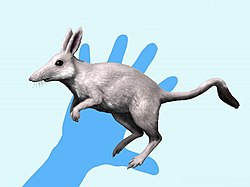| Unnuakomys Temporal range: Maastrichtian | |
|---|---|
 | |
| Unnuakomys (lower left, inside hollow trunk) being stalked by a dromaeosaur, alongside Pachyrhinosaurus | |
| Scientific classification | |
| Kingdom: | Animalia |
| Phylum: | Chordata |
| Class: | Mammalia |
| Family: | † Pediomyidae |
| Genus: | † Unnuakomys Eberle et al., 2019 |
| Type species | |
| †Unnuakomys hutchisoni Eberle et al., 2019 | |
Unnuakomys is an extinct genus of metatherian mammal from the Maastrichtian age of the Late Cretaceous. It was discovered in the Prince Creek Formation of Alaska, and is the northernmost metatherian known. [1] The type (and only) species is U. hutchisoni.





